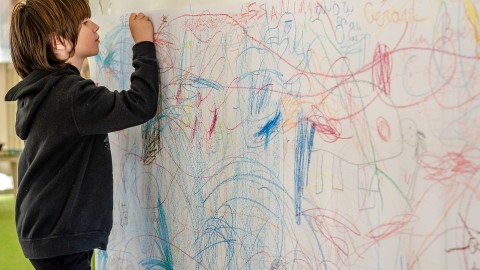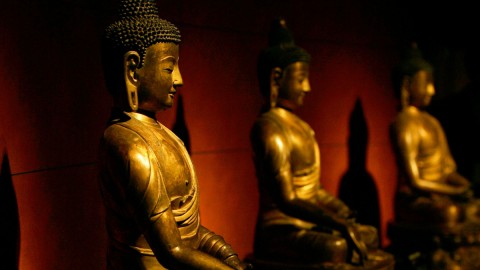The East has written myth. Myth is totally different; it is with psychological time.
The chronological time moves linearly, in a line. That’s why in the West they say there is nothing new under the sun – but history never repeats itself. Time moves in a line, so how can history repeat in a line? Each event seems to be unique. In the East we say history is a wheel. It does not move linearly; the movement is circular. And in the East we say there is nothing new under the sun and history continuously repeats itself. It is all repetition, so why be worried about when Krishna was born?
In the East we say that in each age Krishna is born again and again and again. It is a wheel. In each period between creation and destruction, Krishna is born again and again.
His form may differ, his name may differ, but he is born again and again; so why bother?
Just describe who he is and don’t be worried too much about nonessential details. So it may be that the figure of Krishna may not belong to any Krishna in particular. It may be just a synthesis of all the Krishnas. That’s how it is.
If you ask, “Is Buddha’s statue true to his image?” – It is not. Yet it is true because a Buddha has to be like that. It is not a question whether this Buddha – Gautam Siddharth, son of Shuddhodhan, born in Kapilvastu on a particular date – was like this statue. No, that is not the point. But all the Buddhas are always synthesized in this statue. They represent.
This statue is just a statue of BuddhaHOOD, not of any Buddha in particular. All Buddhas are included in it.
Now this is difficult for the West. You cannot make any difference between Buddha and Mahavir except for a small symbol just down near their feet; otherwise you cannot make much difference. Jainas have twenty-four tirthankaras, twenty-four great Masters, but you cannot make any distinction. Go to a Jaina temple and just look; they all look alike. It is not possible the twenty-four persons were all alike. Impossible. Two persons are never alike, but those statues don’t represent the outward. They represent the inner experience.
Yes, two persons cannot be alike, but two experiences can be alike.
When you fall in love and somebody else falls in love, the love is alike. When you meditate, somebody else meditates, the meditation is alike. When you become enlightened and somebody else becomes enlightened, enlightenment is alike. These twenty-four statues of Jaina Masters are not of twenty-four persons but of one state reflected in twenty-four personalities. They are all representative.
If you see Jaina tirthankaras, you will see very long ears, almost touching their shoulders. Now Jainas say that all tirthankaras have very long ears. And there are foolish people who think as if Mahavir really had such long ears.
Osho was invited by a Jaina, Acharya Tulsi, to one of his conferences. He has very long ears, so one of his disciples came to me and he said, “See, Acharya Tulsiji Maharaj, how long his ears are. That is symbolic of being a great Master. Soon, in one of his lives, he is going to become a tirthankara.” Just by coincidence, or by synchronicity, a donkey passed by, so I told that disciple, “Look at Acharya Donkeyji Maharaj. He is already a tirthankara!” The disciple has been angry since then; he has never come to me.
Long ears are just symbolic that these people were capable of hearing, that’s all. They were capable of hearing the sound, the soundless sound, the sound of one hand clapping.
They were capable of hearing the truth. These statues are just symbolic, not that they are actually representative of some real person. The misinterpretation is foolish, but that’s how it goes on. Myth is symbolic.
It is said Ram was born in Ayodhya. Now Ayodhya is a state of inner peace; it has nothing to do with the town named Ayodhya. The town is named as a representative of the inner state of ayodhya, a very peaceful, silent, blissful state. Of course Ram has to be born out of that.
That is the meaning of Jesus’ birth – out of a virgin soul. Not that actually he was born of a virgin Mary, no; but out of virginity, out of pureness, innocence, uncorrupted purity of being he was born. That was his real womb.
These are symbolic, these are mythological. They are not chronological.
Historians go on collecting rubbish, unnecessary details. You just look in any history book. You will be surprised. Why are there so many people doing such foolish work?
Dates and dates and dates and names and names and names, and they go on and on. And thousands of people waste their whole lives, and they call it research. Then there are journalists, editors, newspaper people; they are chronological. They just go on looking for unnecessary details in the world, for news.
The truth is never news, because it is always there. It does not happen; it has already happened. Untruth is news.
Somebody asked George Bernard Shaw, “What is news?” He said, “When a dog bites a man it is not news, but when a man bites a dog it is news.” Because news has to be something new. A dog biting a man is not news because it is not new. It has always been so and it will always be so. But when a man bites a dog, certainly it is news.
You will not find more futile and superficial people than journalists. They have a knack for finding out useless things. Journalists are impotent politicians. Politicians make news; journalists collect news. Journalists are like shadows to politicians. That’s why newspapers are full of politicians; from this end to that, from the beginning to the end, just politics, politics, politics. A journalist is one who has failed in making news; now he collects it. His relationship to the politician is exactly the same as the relationship of a critic to the poet: one who has failed to become a poet, he becomes a critic.
I have heard about a famous actor. In a certain film he needed a horse, and a horse owner brought his horse. It was an ordinary horse, but the owner started praising the horse very highly, and he said, “This is no ordinary horse. Don’t go by the form; look at his spirit. He is a very great horse, and he has worked in so many movies that you can almost call him an actor.”
Exactly at that moment, the horse broke wind, long and loud.
The actor said, “I can see. He is not only an actor; he is a critic also.”
The journalist, the critic, the historian, the politician, they all hang with the chronological time, with the very periphery of life, the most futile and useless effort that goes on in the world – and has become so important. We have made it so important because we have forgotten that the clock is not life.
The psychological time is dream time. Myth, poetry, love, art, painting, dancing, music, intuition, they all belong to psychological time. You have to move towards psychological time. The chronological time is for the extrovert mind. The psychological time is for the introvert, one who has started moving towards his inner soul.
There are dangers in psychological time also. That’s why those who are obsessed with the chronological are against the psychological. There are dangers. There is a danger you may get trapped in it. Then you will become almost insane because you will be out of touch with the world, with people, with society.
Let me tell you a few anecdotes.
An inoffensive-looking man was busy talking to an old friend of his and completely forgot the time. Suddenly he looked at his watch and said, “Oh, dear, it is three o’clock, and I have an appointment with my psychiatrist at three and it will take at least fifteen minutes to get there.”
His friend said, “Now take it easy. You will only be a few minutes late.”
“You don’t know him. If I am not there on time he will start without me.”
There is a danger of taking the dream, to be the real one. There is a danger of believing in your imagination too much. You can become so obsessed with your inner fantasy, dream world, that you can live in a fog. But even with the dangers it is very important to understand it and to pass through it. But remember, it is a bridge to be passed. When you have passed it, you will come across; real time.
Chronological time corresponds to the body, psychological time to the mind, real time to your being. Chronological time is the extroverted mind, psychological time is the introverted mind, and real time is no-mind.
But one has to pass through the psychological. That territory has to be passed, fully alert.
You should not make your abode there. It is a bridge to be passed; you should not make your abode there. If you make your abode there you become mad. That’s what has happened to many people who are in madhouses. They have forgotten chronological time, they have not reached real time, and they have started living on the bridge, the psychological time. That’s why their reality has become personal and private. A madman lives in a private world, and the man you call sane lives in a public world. The public world is with people, the private world is just confined to yourself; but the real world is neither public nor private. It is universal, it is beyond both. And one has to go beyond both.
A man had a reputation as a road hog. He was lying in a hospital bed after an accident.
The doctor asked the nurse, “How is he this morning?”
She said, “Oh, he keeps putting his right hand out.”
“Ah,” said the doctor, “he is turning the corner.”
A road hog, an automobile addict, even in his sleep goes on driving fast. Whatsoever you do in your dream reflects your desire, your goals, what you would like to have.
Tags: Patanjali Real Time Is No-Mind










